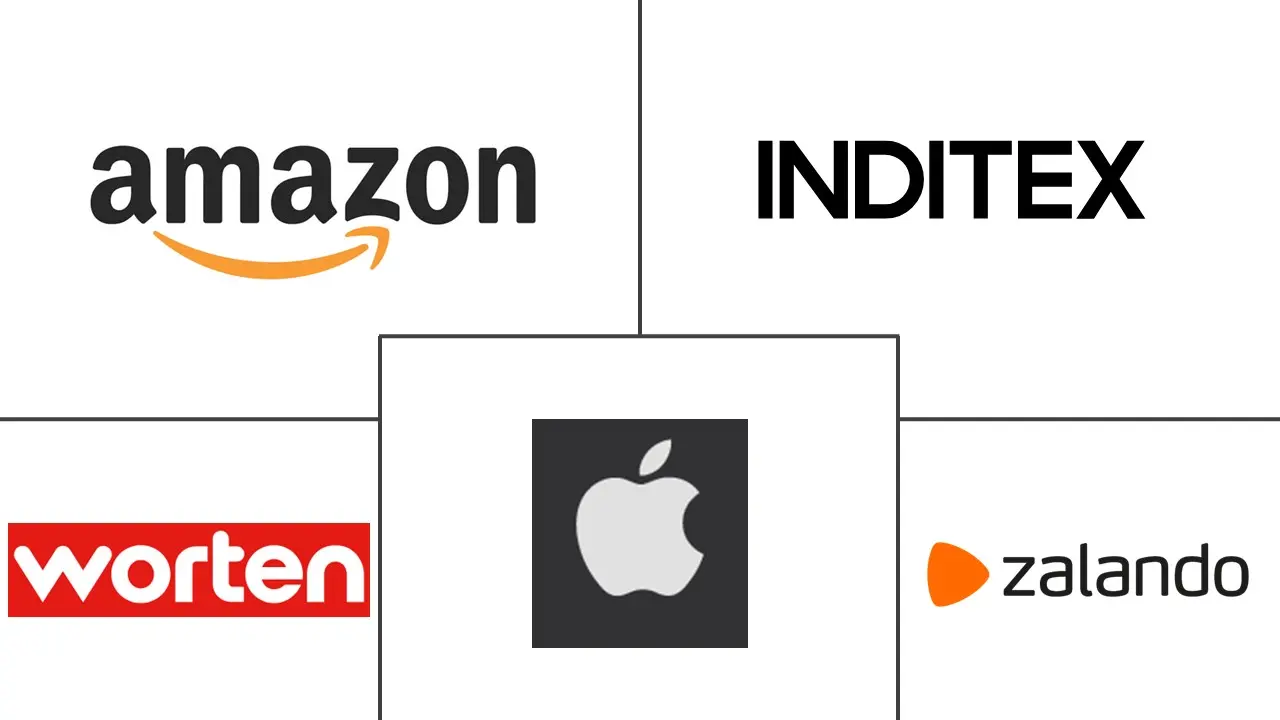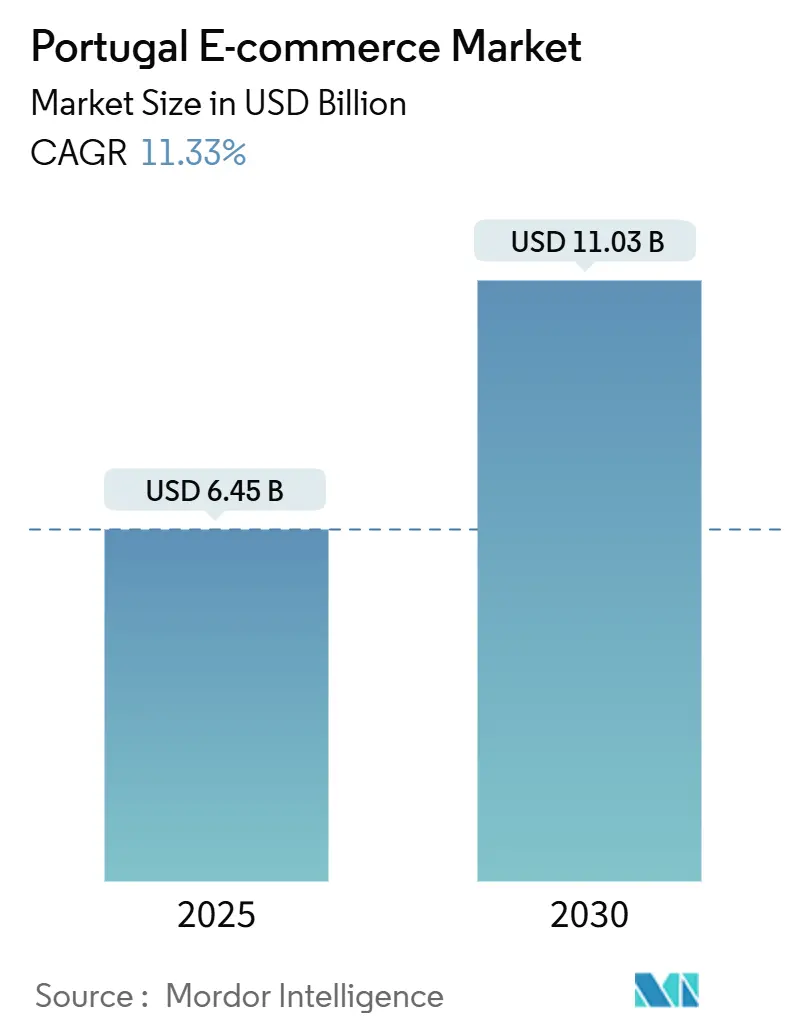
Portugal E-commerce Market Analysis by Mordor Intelligence
The Portugal e-commerce market size is valued at USD 6.45 billion in 2025 and is projected to reach USD 11.03 billion by 2030, advancing at an 11.33% CAGR. Strong logistics upgrades, expanding mobile coverage, and EU-aligned digital regulations are underpinning this double-digit trajectory. Investments by DPD, DHL, and CTT are compressing delivery times below 24 hours, allowing retailers to lower shipping surcharges and widen product ranges. Rapid mobile-commerce (m-commerce) uptake, encouraged by 5G rollouts and 100.5 mobile-broadband subscriptions per 100 inhabitants, is lifting conversion rates and basket sizes. Simultaneously, digital-wallet interoperability through MB Way, Multibanco, and Bizum is cutting cross-border fees and stimulating discretionary spending. EU Recovery and Resilience Funds (RRF) are accelerating SME web-shop launches and intensifying B2B demand for integrated procurement platforms. Against this backdrop, traditional fashion leaders are facing cost headwinds from return rates nearing 30%, while rural last-mile costs in Algarve and the islands remain a structural drag.
Key Report Takeaways
- By business model, the B2C segment held 87.02% of the Portugal e-commerce market share in 2024, whereas B2B is forecast to expand at a 13.51% CAGR to 2030.
- By device type, smartphones accounted for 62.21% of the Portugal e-commerce market size in 2024 and are projected to grow at a 12.15% CAGR through 2030.
- By payment method, credit and debit cards retained 44.32% share of the Portugal e-commerce market size in 2024, while digital wallets are advancing at a 16.32% CAGR to 2030.
- By B2C product category, fashion led with 25.14% of the Portugal e-commerce market share in 2024; food and beverages is forecast to expand at a 15.02% CAGR through 2030.
Portugal E-commerce Market Trends and Insights
Drivers Impact Analysis
| Driver | (~) % Impact on CAGR Forecast | Geographic Relevance | Impact Timeline |
|---|---|---|---|
| Surging Mobile-Commerce Adoption Driven by Lisbon & Porto Consumers | +2.8% | National, concentrated in Lisbon & Porto metropolitan areas | Short term (≤ 2 years) |
| Rapid Uptake of Digital Wallets Enabled by Multibanco & MB Way | +2.1% | National, with cross-border expansion to Spain & Italy | Medium term (2-4 years) |
| EU Recovery & Resilience Funds Accelerating SME Web-shop Launch | +1.7% | National, with priority regions in Norte & Centro | Medium term (2-4 years) |
| Logistics Upgrades (CTT, DHL) Cutting Average Delivery Time Below 24h | +2.3% | National, with enhanced coverage in rural Algarve & Islands | Long term (≥ 4 years) |
| Tourism-Induced Seasonal Demand Peaks Powering Marketplace GMV | +1.4% | Coastal regions, Lisbon, Porto, Algarve tourism corridors | Short term (≤ 2 years) |
| Source: Mordor Intelligence | |||
Surging Mobile-Commerce Adoption Driven by Lisbon & Porto Consumers
Mobile devices already account for 36% of online sales, with average monthly data usage hitting 12.7 GB per user. Retailers are closing legacy showrooms and reallocating budgets to geo-targeted promotions that capitalize on tourist footfall. A 77.8% rise in 5G subscriptions has provided the bandwidth essential for AR-enabled product visualization, driving higher conversion on high-ticket items. Delivery density in the two largest metropolitan areas now supports multiple same-day slots, cutting courier expenses that historically deterred online grocery orders. Data monetization is emerging as a secondary revenue stream as merchants deploy privacy-compliant analytics around location-based push offers.[1]ANACOM, “Communications in Numbers 2025,” anacom.pt
Rapid Uptake of Digital Wallets Enabled by Multibanco & MB Way
Digital wallets are gaining trust because they layer on top of familiar Multibanco rails. MB Way’s partnership with Bizum and Bancomat removes traditional correspondent banking fees, making cross-border purchases seamless for Portuguese shoppers. The model blends interoperability with credit-based products; Klarna has already enrolled 600,000 local users across 3,000 brands. Airlines such as TAP now allow installment payments, demonstrating wallet suitability for high-value travel purchases. This coexistence phase keeps cards dominant for recurring bills yet allows wallets to flourish in discretionary spend.[2]The Portugal News, “MB Way Expands to Bizum Network,” theportugalnews.com
EU Recovery & Resilience Funds Accelerating SME Web-Shop Launch
RRF grants are covering software licensing, ERP integration, and digital-skills training for small firms. As onboarding barriers drop, suppliers of inventory management, last-mile fulfillment, and performance marketing gain secondary demand. Textile SMEs are using the funds to deploy mass-customization tools, defending against low-cost imports and creating locally produced SKUs with quicker turnaround.[3]Revista Industria Textila, “Digital Transformation in Portuguese Textile SMEs,” revistainustriatextila.ro
Logistics Upgrades (CTT, DHL) Cutting Average Delivery Time Below 24 h
CTT’s Sunday service and DHL’s Porto hub expansion are synchronizing import and domestic networks, enabling same-day delivery in high-density corridors while lowering rural lead times from 72 hours to sub-48 hours. Retailers such as Lidl have answered with EUR 115 million (USD 123.2 million) warehouse investments to support dark-store models that shave 30% off last-mile costs for chilled products. Faster transit lets merchants hold leaner inventory, releasing working capital for marketing.
Restraints Impact Analysis
| Restraint | (~) % Impact on CAGR Forecast | Geographic Relevance | Impact Timeline |
|---|---|---|---|
| Persistent Last-Mile Costs in Rural Algarve & Islands | -1.9% | Rural Algarve, Azores, Madeira archipelagos | Long term (≥ 4 years) |
| Higher Return Rates in Fashion Raising Reverse-Logistics Expenses | -1.3% | National, concentrated in urban fashion retail segments | Medium term (2-4 years) |
| Low Digital Skills in 55+ Cohort Limiting Shopper Pool | -0.8% | National, with rural concentration effects | Long term (≥ 4 years) |
| Stricter EU Digital Services Act Compliance Costs for SMEs | -0.7% | National, disproportionate impact on smaller merchants | Short term (≤ 2 years) |
| Source: Mordor Intelligence | |||
Persistent Last-Mile Costs in Rural Algarve & Islands
Low drop-density keeps delivery expenses roughly 50% of total shipping spend in remote districts, compared with 30-35% in urban zones. Island deliveries also face ferry scheduling and weather disruptions that inflate lead times and undermine reliability. While electric vans lower urban costs by up to 25%, sparse charging infrastructure limits similar gains outside metro areas. Parcel lockers help, yet adoption among older residents remains modest.
Higher Return Rates in Fashion Raising Reverse-Logistics Expenses
Returns near 30% erode margins and complicate working-capital cycles. Virtual fitting rooms can trim the ratio by a third but require costly 3D garment mapping and AR integration. Smaller boutiques lacking scale must outsource to third-party handlers, facing higher per-unit processing fees and markdown risk when items miss their fashion season.
Segment Analysis
By Business Model: Digital Procurement Broadens Revenue Pools
B2C remains the backbone of the Portugal e-commerce market, yet B2B sales are compounding 2 percentage-points faster. Enterprise buyers value audit trails and ERP integration that consumer-grade platforms lack. RRF incentives are stimulating portal launches that connect local manufacturers with EU buyers, translating into a 13.51% CAGR for B2B through 2030. The Portugal e-commerce market size for B2B transactions is projected to capture an expanding slice of total GMV as SMEs digitize tendering processes. Conversely, mature B2C players are deepening omnichannel services such as click-and-collect to defend their 87.02% share without incurring heavy logistics outlays.
With invoicing thresholds rising under EU VAT reforms, B2B sellers are deploying automated compliance checks to reduce error penalties. This back-office maturity positions them for seamless cross-border expansion, reversing the earlier perception that e-commerce suits only consumer goods. Consolidation forces may emerge as platforms race to reach liquidity levels that justify investment in e-invoicing, dynamic discounting, and credit scoring.
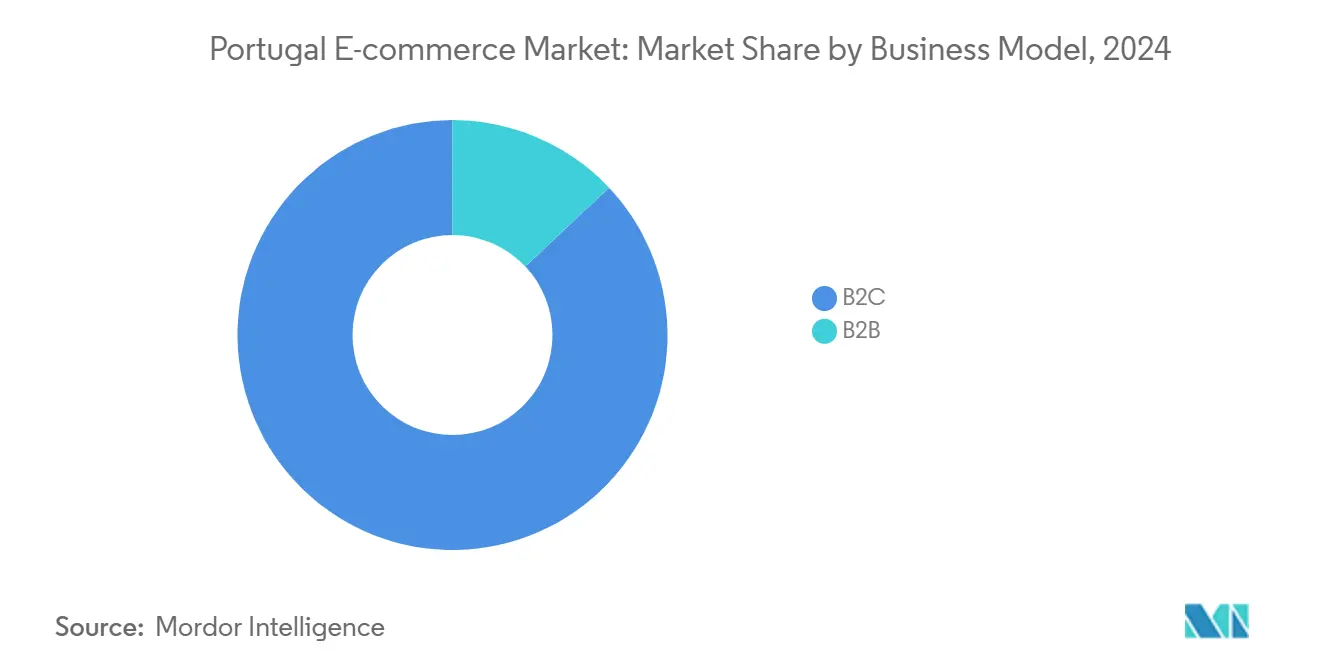
By Device Type: Mobile Shopping Establishes the Experience Benchmark
Smartphones generated 62.21% of transactions in 2024 and will remain the primary interface as Portugal’s 5G adoption passes 4 million users. Cart-conversion studies show a 15-basis-point lift when page load times fall below two seconds, prompting retailers to prioritize lightweight native apps over desktop-optimized sites. The Portugal e-commerce market share of smartphones is expected to widen as handsets become the locus of loyalty programs and contextual promotions.
Desktop traffic persists for research-intensive categories such as furniture, where large screens aid configuration and price comparison. Hybrid purchases start on mobile discovery but finish on desktop checkout, signaling the need for synchronized cart functionality. Emerging form factors, like smart TVs and voice assistants, remain experimental yet could support high-margin impulse buys linked to entertainment content.
By Payment Method: Wallet Interoperability Reshapes Checkout Economics
Digital wallets are advancing at a 16.32% CAGR, yet plastic cards still command 44.32% of payment volume. Wallets thrive on lower merchant fees and instant settlement, giving SMEs cash-flow relief. The Portugal e-commerce market size linked to wallets will swell as MB Way adds Spanish and Italian corridors, smoothing cross-border consumer journeys without new KYC protocols.
Buy-now-pay-later (BNPL) bridges the affordability gap, evidenced by Klarna’s 600,000-strong user base. Airlines and electronics retailers are integrating BNPL at the order summary page to prevent churn during price-sensitive checkouts. Cryptocurrency remains fringe, constrained by volatility and limited merchant acceptance, yet it signals consumer appetite for alternative stores of value where FX spreads are material.
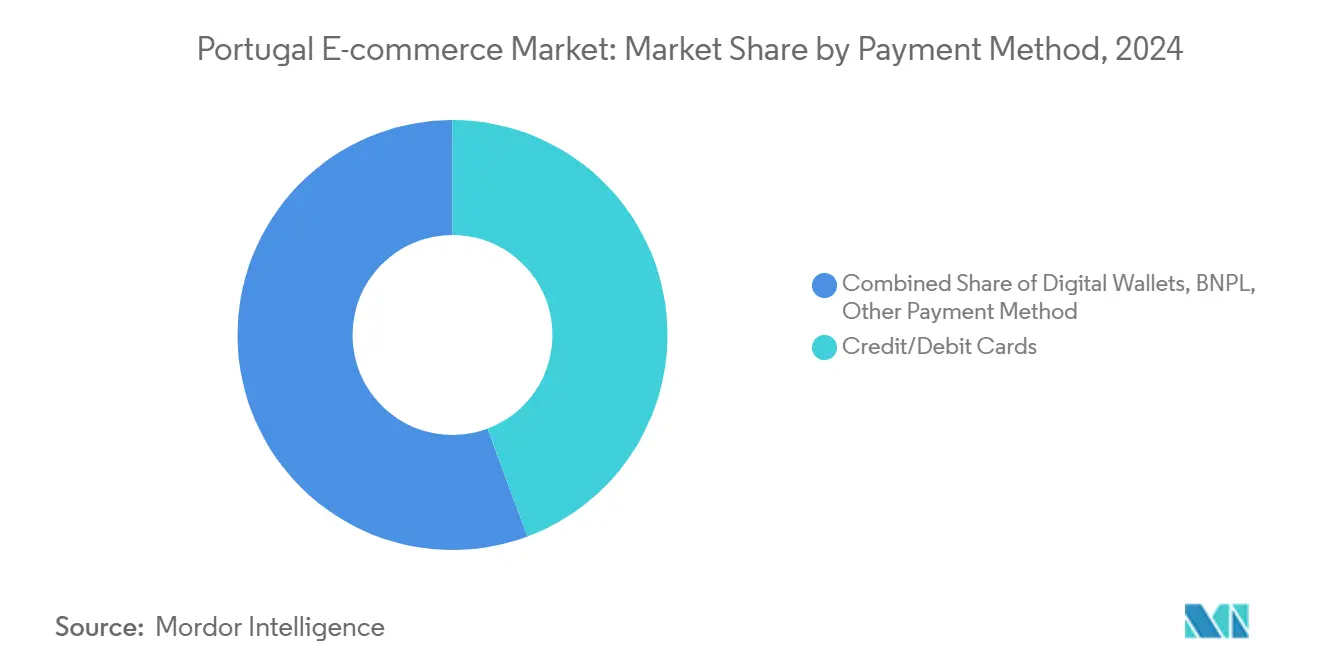
Note: Segment shares of all individual segments available upon report purchase
By B2C Product Category: Food Delivery Outstrips Fashion in Momentum
Fashion kept a 25.14% revenue lead but sees volume erosion from rising return expenses. In contrast, food and beverages are on a 15.02% growth path, aided by dark-store networks and insulated packaging that lowers spoilage. The Portugal e-commerce market size for food delivery will benefit from quick-commerce pilots promising 30-minute fulfillment in Lisbon and Porto.
Consumer electronics retain stable demand cycles tied to product launches, while home-furnishing portals deploy AR room-planning to cut abandoned carts. Specialty verticals such as eco-friendly goods are gaining visibility through marketplace filters signaling verified sustainability claims, aligning with consumer focus on origin and carbon impact.
Geography Analysis
Lisbon and Porto dominate gross merchandise value (GMV) due to higher disposable incomes and proximity to upgraded DHL and CTT hubs. Same-day delivery and dense pick-up networks have become standard expectations in these metros, reinforcing brand loyalty. Their consumer bases also test early AR and AI retail pilots, giving merchants data to refine nationwide rollouts.
Interior districts and the Algarve hinterland struggle with low delivery densities that keep shipping surcharges high. Seasonal tourism spikes offer volume but not year-round justification for permanent hubs. Locker installations and micro-fulfillment centers are being trialed to compress the rural cost curve, yet consumer habits and lower order frequency slow payback.
Island regions face multi-modal logistics and weather uncertainties that extend lead times. Sub-24-hour targets remain elusive despite ferry and air-cargo subsidies. Some merchants are exploring drop-ship models from Spanish ports to bypass mainland detours, but customs and VAT handling introduce complexity. Cross-border e-commerce with Spain is nonetheless expanding, helped by MB Way-Bizum interoperability that eliminates FX fees and accelerates settlement.
Competitive Landscape
Global market makers such as Amazon and Inditex anchor the top tier, capturing scale through sophisticated inventory pooling and private-label penetration. Continente Online leverages grocery leadership to iterate on chilled last-mile solutions, while Worten converges electronics and home appliances under a single marketplace interface. Collectively, the top five actors control an estimated 45-50% of GMV, suggesting moderate concentration with room for niche entrants.
Technology innovation is a key battleground. Sensei’s autonomous-store stack enables cashier-less operations, slashing queue times and gathering granular basket data. Continente Labs runs computer-vision pilots that pre-populate carts via QR codes for frictionless checkout at its Lisbon concept store. Logistics automation is spreading: DHL’s Porto hub applies AI route optimization, and DPD’s Loures facility integrates 120 EV charging stations to future-proof its fleet.
Sustainability differentiators are growing. Pegada Verde markets eco-home products with verified carbon metrics, tapping consumers who prioritize ethical consumption. Fashion platforms experiment with on-demand production to curb overstock. To retain share, incumbents are forging payment alliances-e.g., partnership with PIX to tap 1 million annual Brazilian visitors-while smaller merchants band together on curated marketplaces to match delivery SLAs.
Portugal E-commerce Industry Leaders
-
Inditex Group (Zara Portugal)
-
Worten
-
Amazon Inc.
-
Apple Inc.
-
Zalando Inc.
- *Disclaimer: Major Players sorted in no particular order
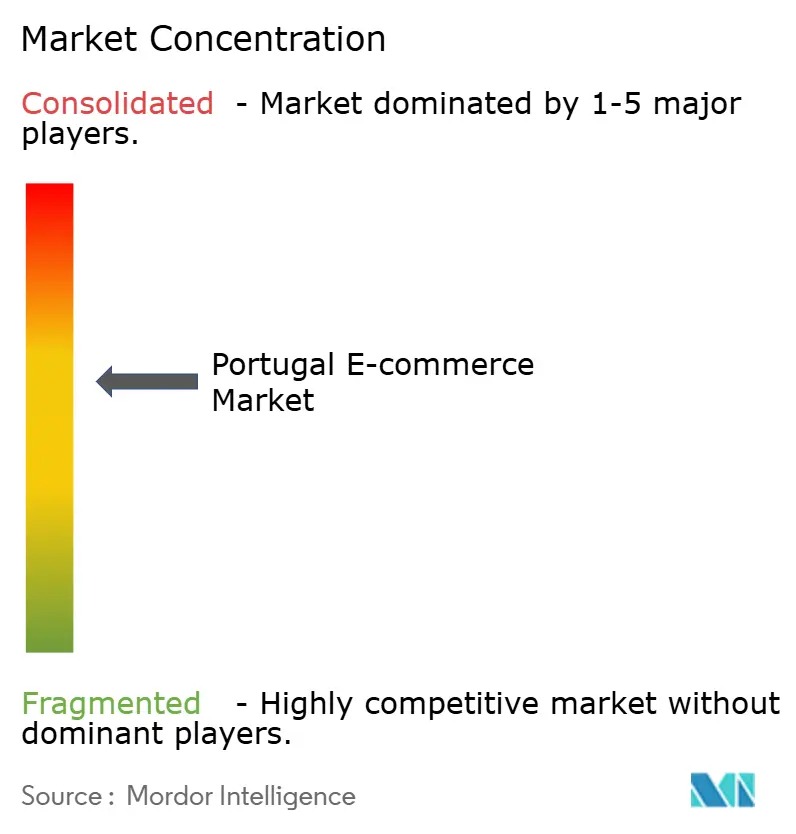
Recent Industry Developments
- May 2025: FCamara partnered with Shopify to fast-track Iberian digital-commerce projects, targeting mid-market Portuguese firms eyeing US and Northern European exports.
- April 2025: TAP Air Portugal integrated Klarna BNPL, becoming Western Europe’s first airline to split ticket payments into three equal instalments without interest.
- March 2025: Leroy Merlin earmarked EUR 220 million (USD 235.8 million) over three years—half for infrastructure, half for tech upgrades—to integrate AI inventory forecasting across its Portuguese network.
- January 2025: El Corte Inglés and Worten began accepting Brazil’s PIX real-time payments via Unicre and Braza Bank, opening Portugal e-commerce market access to more than 1 million Brazilian travelers each year.
Research Methodology Framework and Report Scope
Market Definitions and Key Coverage
Our analysts define the Portuguese e-commerce market as every paid digital transaction in which a resident buyer uses an internet-enabled device to purchase physical goods or fee-based services that are fulfilled within Portugal or shipped from abroad. According to Mordor Intelligence, values are expressed as gross merchandise value (GMV) in U.S. dollars after converting euro sales with the yearly average exchange rate.
Scope Exclusions: Second-hand peer-to-peer deals, in-app micro-payments for gaming, and purely business-to-government platforms are outside the study.
Segmentation Overview
- By Business Model
- B2C
- B2B
- By Device Type
- Smartphone / Mobile
- Desktop and Laptop
- Other Device Types
- By Payment Method
- Credit / Debit Cards
- Digital Wallets
- BNPL
- Other Payment Method
- By B2C Product Category
- Beauty and Personal Care
- Consumer Electronics
- Fashion and Apparel
- Food and Beverages
- Furniture and Home
- Toys, DIY and Media
- Other Product Categories
Detailed Research Methodology and Data Validation
Primary Research
Our team interviewed marketplace operators, parcel integrators, payment processors, and SME web-shop owners across Lisbon, Porto, and Algarve. These conversations clarified cart-level return rates, cross-border order shares, and realistic adoption timelines for digital wallets, enabling us to stress-test the secondary data and refine elasticities.
Desk Research
We began with structured pulls from Statistics Portugal, Eurostat retail trade dashboards, and the European Central Bank's payment instrument files, which gave baseline sales, card volumes, and average ticket sizes. Trade association briefs from ACEPI and Ecommerce Europe added shipment counts and shopper penetration by age group. Company filings, public earnings calls, and customs import records enriched category splits, while subscription datasets such as D&B Hoovers and Dow Jones Factiva helped trace revenue flows of leading platforms. This mix established the factual spine.
Government white papers on the EU Recovery and Resilience Plan, patent abstracts on logistics automation from Questel, and press coverage on 5G roll-outs supplied trend variables that anchor our demand drivers. The sources listed illustrate our approach; many more publications and databases were reviewed for accuracy and context.
Market-Sizing & Forecasting
Mordor's model starts with a top-down reconstruction of national e-commerce receipts reported by Statistics Portugal, which are then split by product class using payment processor share data and ACEPI shopper surveys. Supplier roll-ups of major retailers, plus sampled average selling price times volume checks, act as a bottom-up sense-check of totals. Key inputs include smartphone penetration, parcel delivery density, disposable income per capita, digital wallet transaction counts, cross-border order share, and return-rate trends; each variable is projected through multivariate regression, feeding an ARIMA overlay to capture seasonality. Gaps in line-item estimates are bridged with expert-validated ratios and three-year moving averages before final consolidation.
Data Validation & Update Cycle
Outputs pass variance filters against independent indicators such as VAT receipts and postal parcel volumes. Senior analysts review anomalies, and findings are peer-reviewed before sign-off. The model refreshes annually, with interim updates when policy shifts or macro shocks materially alter inputs.
Why Our Portugal E-commerce Baseline Commands High Credibility
Published figures often differ because every firm sets its own service mix, currency treatment, and refresh rhythm. We acknowledge these variations up front so users can see how scope choices ripple through the math.
Key gap drivers include whether services like travel or streaming are counted, how cross-border flows are handled, and the cadence at which exchange rates and inflation adjustments are rolled forward; Mordor updates all three every year, whereas others may freeze assumptions for longer.
Benchmark comparison
| Market Size | Anonymized source | Primary gap driver |
|---|---|---|
| USD 10.12 B (2024) | Mordor Intelligence | |
| USD 8.66 B (2024) | Global Consultancy A | Excludes fee-based services and uses 2023 shopper mix without mid-year refresh |
| USD 4.69 B (2024) | Data Platform B | Counts retail goods only and relies on modeled baskets with limited cross-border capture |
| USD 6.67 B (2024) | Research House C | Applies average 2023 forex and a pure top-down GDP share ratio |
The comparison shows that when scope is narrower or input updates lag, estimates skew lower, while our disciplined variable tracking and annual recalibration give decision-makers a balanced, transparent baseline they can readily audit.
Key Questions Answered in the Report
What is the current size of the Portugal e-commerce market?
The market is valued at USD 6.45 billion in 2025 and is projected to reach USD 11.03 billion by 2030.
Which segment is growing fastest in the Portugal e-commerce market?
B2B transactions are forecast to grow at a 13.51% CAGR, outpacing B2C despite the latter’s larger base.
How important is mobile commerce in Portugal?
Smartphones already account for 62.21% of transactions, and mobile commerce continues to grow at a 12.15% CAGR.
Which payment methods are Portuguese shoppers adopting most rapidly?
Digital wallets, led by MB Way and Klarna, are expanding at a 16.32% CAGR, though cards still hold 44.32% share.
What logistical improvements are influencing online retail growth?
Investments by DHL, DPD, and CTT are cutting average delivery times below 24 hours in urban areas and enhancing capacity for rural and island deliveries.
How concentrated is the competitive landscape?
The top five players control roughly 45-50% of market sales, reflecting moderate concentration with scope for new entrants.
Page last updated on:
